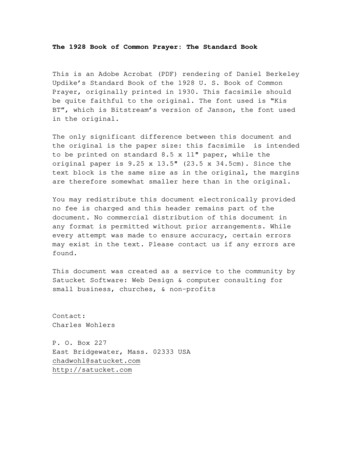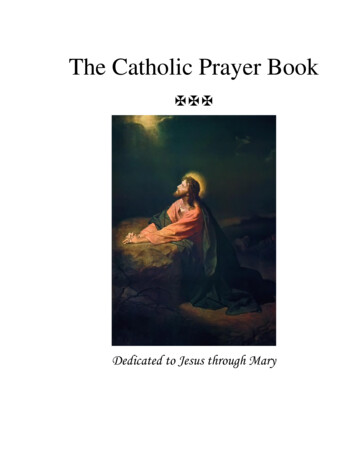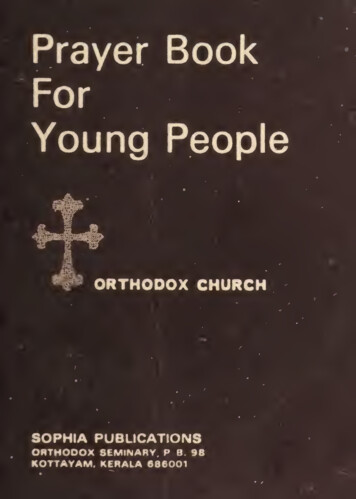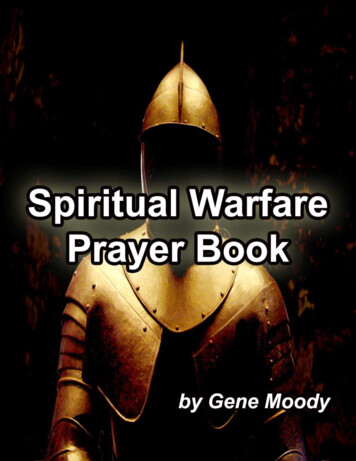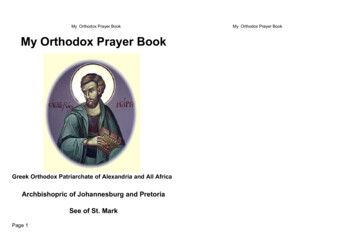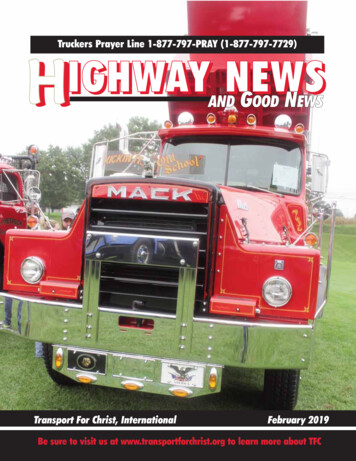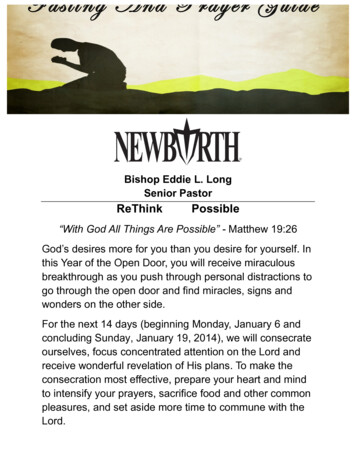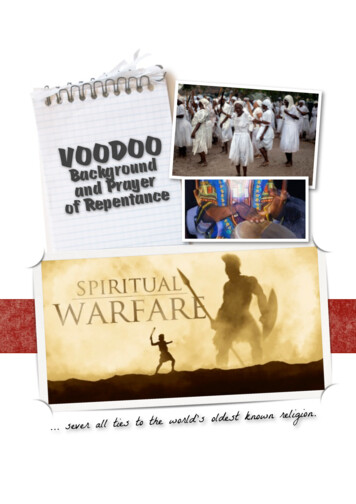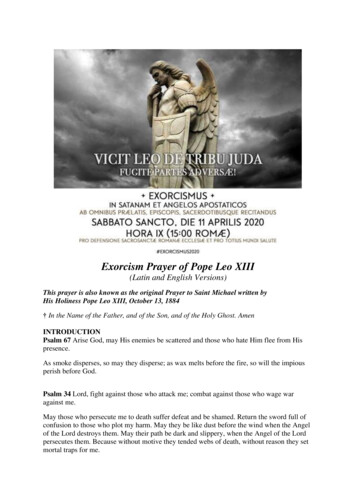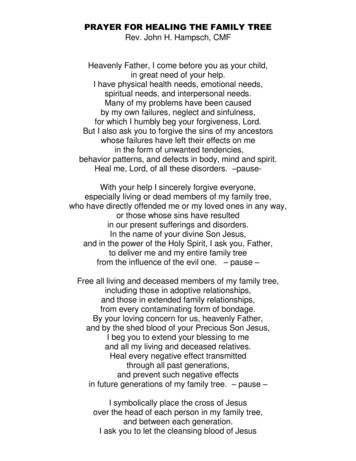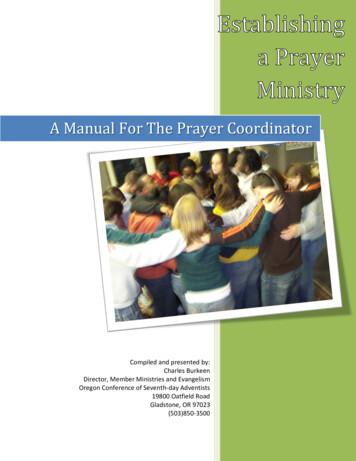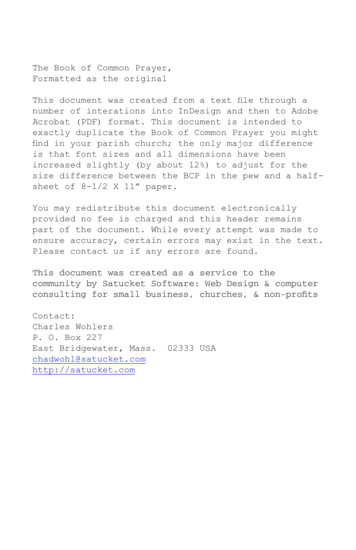
Transcription
The Book of Common Prayer,Formatted as the originalThis document was created from a text file through anumber of interations into InDesign and then to AdobeAcrobat (PDF) format. This document is intended toexactly duplicate the Book of Common Prayer you mightfind in your parish church; the only major differenceis that font sizes and all dimensions have beenincreased slightly (by about 12%) to adjust for thesize difference between the BCP in the pew and a halfsheet of 8-1/2 X 11” paper.You may redistribute this document electronicallyprovided no fee is charged and this header remainspart of the document. While every attempt was made toensure accuracy, certain errors may exist in the text.Please contact us if any errors are found.This document was created as a service to thecommunity by Satucket Software: Web Design & computerconsulting for small business, churches, & non-profitsContact:Charles WohlersP. O. Box 227East Bridgewater, Mass.chadwohl@satucket.comhttp://satucket.com02333 USA
TheBook ofCommonPrayerand Administration of the Sacramentsand Other Ritesand Ceremonies of the ChurchTogether with The Psalter or Psalms of DavidAccording to the use ofThe Episcopal Church
[This page contains the Certificate of theoriginal. Note that this electronic text isNOT certified or approved by the Custodian ofthe Standard Book of Common Prayer.]CertificateI certify that this edition of The Book of Common Prayerhas been compared with a certified copy of the Standard Book,as the Canon directs, and that it conforms thereto.Charles Mortimer GuilbertCustodian of the Standard Book of Common PrayerSeptember, 1979
Table of ContentsThe Ratification of the Book of Common PrayerThe Preface9Concerning the Service of the Church 13The Calendar of the Church Year 15The Daily OfficeDaily Morning Prayer: Rite One 37Daily Evening Prayer: Rite One 61Daily Morning Prayer: Rite Two 75Noonday Prayer 103Order of Worship for the Evening 108Daily Evening Prayer: Rite Two 115Compline 127Daily Devotions for Individuals and FamiliesTable of Suggested Canticles 144The Great Litany148The Collects: TraditionalSeasons of the Year 159Holy Days 185Common of Saints 195Various Occasions 1998137
The Collects: ContemporarySeasons of the Year 211Holy Days 237Common of Saints 246Various Occasions 251Proper Liturgies for Special DaysAsh Wednesday 264Palm Sunday 270Maundy Thursday 274Good Friday 276Holy Saturday 283The Great Vigil of Easter 285Holy Baptism299The Holy EucharistAn Exhortation 316A Penitential Order: Rite One 319The Holy Eucharist: Rite One 323A Penitential Order: Rite Two 351The Holy Eucharist: Rite Two 355Prayers of the People 383Communion under Special Circumstances 396An Order for Celebrating the Holy Eucharist 400Pastoral OfficesConfirmation 413A Form of Commitment to Christian Service 420Celebration and Blessing of a Marriage 423The Blessing of a Civil Marriage 433An Order for Marriage 435Thanksgiving for the Birth or Adoption of a Child 439Reconciliation of a Penitent 447Ministration to the Sick 453Ministration at the Time of Death462
Burial of the Dead: Rite OneBurial of the Dead: Rite TwoAn Order for Burial 506469491Episcopal ServicesOrdination of a Bishop 511Ordination of a Priest 525Ordination of a Deacon 537Litany for Ordinations 548Celebration of a New Ministry 557Consecration of a Church or Chapel 567The Psalter, or Psalms of DavidPrayers and Thanksgivings585810An Outline of the Faith, or CatechismHistorical Documents of the Church(including the Articles of Religion)845864Tables for Finding the Date of Easter and other Holy DaysThe Lectionary888Year A 889Year B 900Year C 911Holy Days 921Common of Saints 925Various Occasions 927Daily Office Lectionary934Seasons of the Year 936Holy Days 996Special Occasions 1000880
The Ratification ofThe Book of Common Prayer (1789)By the Bishops, the Clergy, and the Laity of the Protestant EpiscopalChurch in the United States of America, in Convention, this SixteenthDay of October, in the Year of Our Lord One Thousand Seven Hundredand Eighty-Nine.This Convention having, in their present session, set forth A Book ofCommon Prayer, and Administration of the Sacraments, and other Ritesand Ceremonies of the Church, do hereby establish the said Book: Andthey declare it to be the Liturgy of this Church: And require that it bereceived as such by all the members of the same: And this Book shall be inuse from and after the First Day of October, in the Year of our Lord onethousand seven hundred and ninety.8Ratification
PrefaceIt is a most invaluable part of that blessed “liberty wherewith Christhath made us free,” that in his worship different forms and usages maywithout offence be allowed, provided the substance of the Faith be keptentire; and that, in every Church, what cannot be clearly determined tobelong to Doctrine must be referred to Discipline; and therefore, bycommon consent and authority, may be altered, abridged, enlarged,amended, or otherwise disposed of, as may seem most convenient for theedification of the people, “according to the various exigency of times andoccasions.”The Church of England, to which the Protestant Episcopal Church inthese States is indebted, under God, for her first foundation and a longcontinuance of nursing care and protection, hath, in the Preface of herBook of Common Prayer, laid it down as a rule, that “The particularForms of Divine Worship, and the Rites and Ceremonies appointed to beused therein, being things in their own nature indifferent, and alterable,and so acknowledged; it is but reasonable that upon weighty andimportant considerations, according to the various exigency of times andoccasions, such changes and alterations should be made therein, as tothose that are in place of Authority should, from time to time, seem eithernecessary or expedient.”The same Church hath not only in her Preface, but likewise in her Articlesand Homilies, declared the necessity and expediency of occasionalalterations and amendments in her Forms of Public Worship; and we findaccordingly, that, seeking to keep the happy mean between too muchstiffness in refusing, and too much easiness in admitting variations inPreface 9
things once advisedly established, she hath, in the reign of several Princes,since the first compiling of her Liturgy in the time of Edward the Sixth,upon just and weighty considerations her thereunto moving, yielded tomake such alterations in some particulars, as in their respective timeswere thought convenient; yet so as that the main body and essential partsof the same (as well in the chiefest materials, as in the frame and orderthereof) have still been continued firm and unshaken.Her general aim in these different reviews and alterations hath been, asshe further declares in her said Preface, to do that which, according to herbest understanding, might most tend to the preservation of peace andunity in the Church; the procuring of reverence, and the exciting of pietyand devotion in the worship of God; and, finally, the cutting off occasion,from them that seek occasion, of cavil or quarrel against her Liturgy. Andalthough, according to her judgment, there be not any thing in it contraryto the Word of God, or to sound doctrine, or which a godly man may notwith a good conscience use and submit unto, or which is not fairlydefensible, if allowed such just and favourable construction as incommon equity ought to be allowed to all human writings; yet upon theprinciples already laid down, it cannot but be supposed that furtheralterations would in time be found expedient. Accordingly, a Commissionfor a review was issued in the year 1689: but this great and good workmiscarried at that time; and the Civil Authority has not since thoughtproper to revive it by any new Commission.But when in the course of Divine Providence, these American Statesbecame independent with respect to civil government, their ecclesiasticalindependence was necessarily included; and the different religiousdenominations of Christians in these States were left at full and equalliberty to model and organize their respective Churches, and forms ofworship, and discipline, in such manner as they might judge mostconvenient for their future prosperity; consistently with the constitutionand laws of their country.The attention of this Church was in the first place drawn to thosealterations in the Liturgy which became necessary in the prayers for ourCivil Rulers, in consequence of the Revolution. And the principal careherein was to make them conformable to what ought to be the properend of all such prayers, namely, that “Rulers may have grace, wisdom,10 Preface
and understanding to execute justice, and to maintain truth;” and that thepeople “may lead quiet and peaceable lives, in all godliness and honesty.”But while these alterations were in review before the Convention, theycould not but, with gratitude to God, embrace the happy occasion whichwas offered to them (uninfluenced and unrestrained by any worldlyauthority whatsoever) to take a further review of the Public Service, andto establish such other alterations and amendments therein as might bedeemed expedient.It seems unnecessary to enumerate all the different alterations andamendments. They will appear, and it is to be hoped, the reasons of themalso, upon a comparison of this with the Book of Common Prayer of theChurch of England. In which it will also appear that this Church is farfrom intending to depart from the Church of England in any essentialpoint of doctrine, discipline, or worship; or further than localcircumstances require.And now, this important work being brought to a conclusion, it is hopedthe whole will be received and examined by every true member of ourChurch, and every sincere Christian, with a meek, candid, and charitableframe of mind; without prejudice or prepossessions; seriously consideringwhat Christianity is, and what the truths of the Gospel are; and earnestlybeseeching Almighty God to accompany with his blessing every endeavourfor promulgating them to mankind in the clearest, plainest, most affectingand majestic manner, for the sake of Jesus Christ, our blessedLord and Saviour.Philadelphia, October, 1789.Preface 11
Concerning the Serviceof the ChurchThe Holy Eucharist, the principal act of Christian worship on the Lord’sDay and other major Feasts, and Daily Morning and Evening Prayer, asset forth in this Book, are the regular services appointed for publicworship in this Church.In addition to these services and the other rites contained in this Book,other forms set forth by authority within this Church may be used. Also,subject to the direction of the bishop, special devotions taken from thisBook, or from Holy Scripture, may be used when the needs of thecongregation so require.For special days of fasting or thanksgiving, appointed by civil or Churchauthority, and for other special occasions for which no service or prayerhas been provided in this Book, the bishop may set forth such forms asare fitting to the occasion.In all services, the entire Christian assembly participates in such a waythat the members of each order within the Church, lay persons, bishops,priests, and deacons, fulfill the functions proper to their respectiveorders, as set forth in the rubrical directions for each service.The leader of worship in a Christian assembly is normally a bishop orpriest. Deacons by virtue of their order do not exercise a presidingfunction; but, like lay persons, may officiate at the Liturgy of the Word,whether in the form provided in the Daily Offices, or (when a bishop orpriest is not present) in the form appointed at the Eucharist. Underexceptional circumstances, when the services of a priest cannot beobtained, the bishop may, at discretion, authorize a deacon to presideService of the Church 13
at other rites also, subject to the limitations described in the directionsfor each service.In any of the Proper Liturgies for Special Days, and in other servicescontained in this Book celebrated in the context of a Rite One service,the contemporary idiom may be conformed to traditional language.Hymns referred to in the rubrics of this Book are to be understood asthose authorized by this Church. The words of anthems are to be fromHoly Scripture, or from this Book, or from texts congruent with them.On occasion, and as appropriate, instrumental music may be substitutedfor a hymn or anthem.Where rubrics indicate that a part of a service is to be “said,” it must beunderstood to include “or sung,” and vice versa.When it is desired to use music composed for them, previously authorizedliturgical texts may be used in place of the corresponding texts in thisBook.Scriptural citations in this Book, except for the Psalms, follow thenumeration of the Revised Standard Version of the Bible.14 Service of the Church
The Calendarof the Church YearThe Church Year consists of two cycles of feasts and holy days: one isdependent upon the movable date of the Sunday of the Resurrection orEaster Day; the other, upon the fixed date of December 25, the Feast ofour Lord’s Nativity or Christmas Day.Easter Day is always the first Sunday after the full moon that falls on orafter March 21. It cannot occur before March 22 or after April 25.The sequence of all Sundays of the Church Year depends upon the date ofEaster Day. But the Sundays of Advent are always the four Sundaysbefore Christmas Day, whether it occurs on a Sunday or a weekday. Thedate of Easter also determines the beginning of Lent on Ash Wednesday,and the feast of the Ascension on a Thursday forty days after Easter Day.1. Principal FeastsThe Principal Feasts observed in this Church are the following:Easter DayAscension DayThe Day of PentecostTrinity SundayAll Saints’ Day, November 1Christmas Day, December 25The Epiphany, January 6These feasts take precedence of any other day or observance. All Saints’Day may always be observed on the Sunday following November 1, inaddition to its observance on the fixed date.Calendar 15
Book of Common Prayer, laid it down as a rule, that “The particular Forms of Divine Worship, and the Rites and Ceremonies appointed to be used therein, being things in their own nature indifferent, and alterable, and so acknowledged; it is but reasonable that upon weighty and important considerations, according to the various exigency of times and occasions, such changes and alterations .
